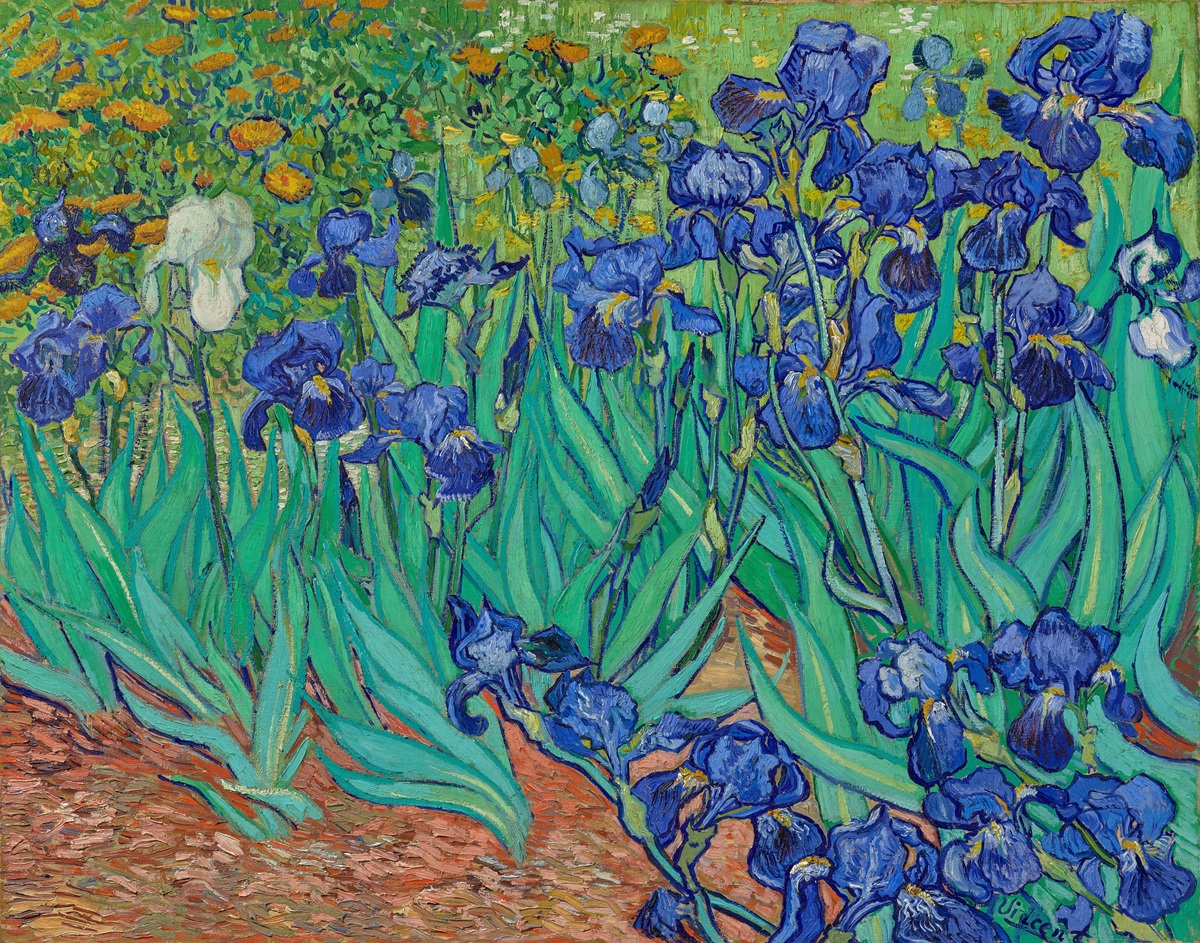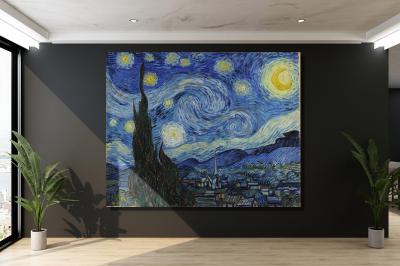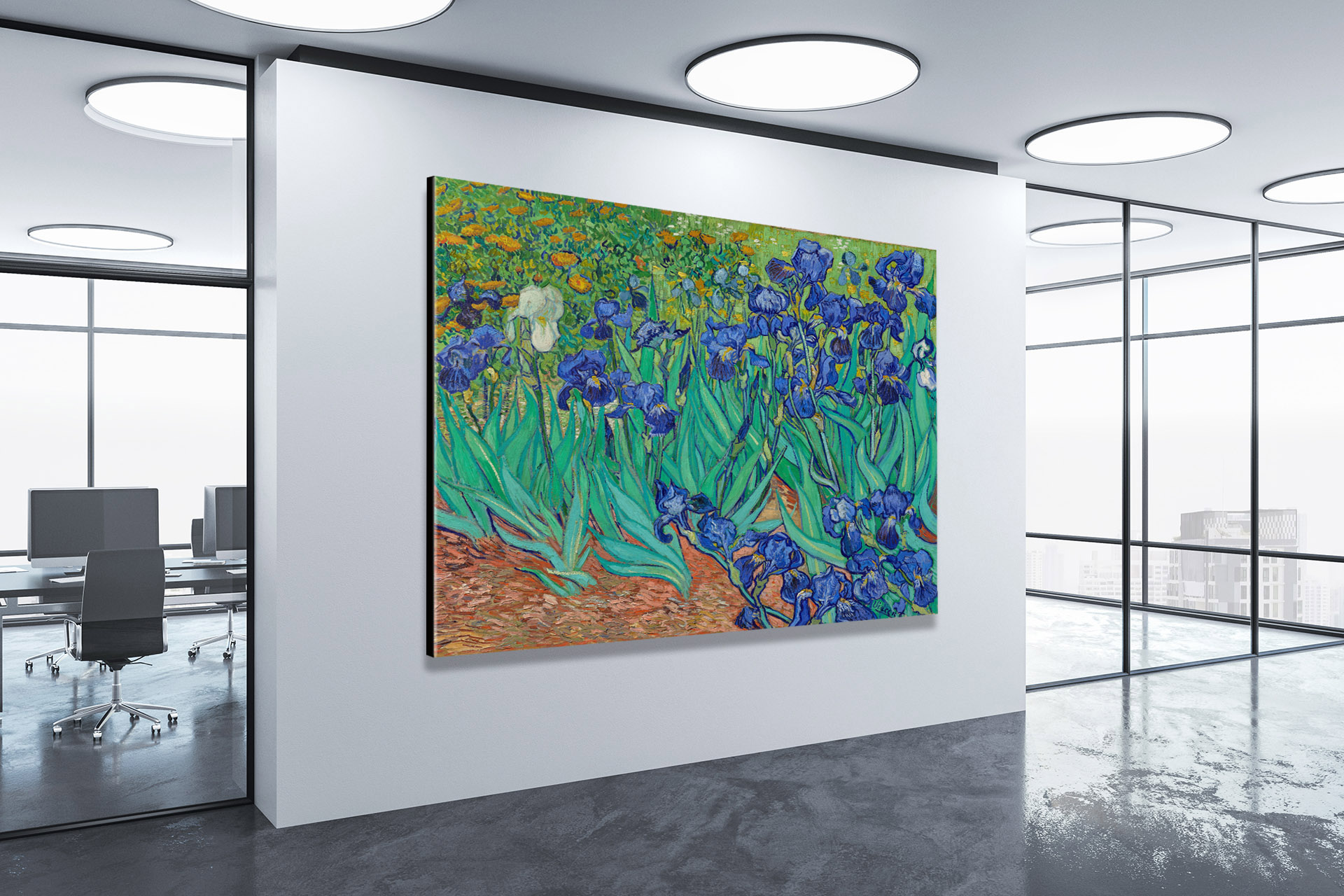Irises
By Vincent van Gogh, 1889
Irises: Vincent van Gogh’s Vibrant Symphony of Nature, Emotion, and Technical Mastery
Vincent van Gogh, an enigmatic and iconic figure in the art world, left behind an astonishing legacy of paintings that continue to captivate the hearts and minds of art enthusiasts across the globe. Among his many remarkable works, “Irises” stands as a luminous confirmation to his exceptional artistic prowess and emotional depth. In this comprehensive exploration, we embark on a journey deep into the heart of “Irises,” uncovering the layers of meaning, beauty, and technical challenges that make it a masterpiece beyond compare.
The Complex Canvas of Van Gogh’s Life
To fully appreciate “Irises,” one must first understand the complex tapestry of Vincent van Gogh’s life. Born in 1853 in the Netherlands, van Gogh’s existence was marked by hardship, poverty, and the relentless specter of mental illness. His turbulent journey through life led him on a relentless quest to find solace and meaning through art. Despite the shadows that loomed over him, van Gogh’s creative brilliance shone through, resulting in a profound and prolific body of work.
“Irises” Large Canvas Prints from WhiteClouds
A Glimpse into the Saint-Paul-de-Mausole Asylum
“Irises” came to life in 1889 while van Gogh resided at the Saint-Paul-de-Mausole asylum in Saint-Rémy-de-Provence, France. This period, marked by both personal turmoil and artistic prolificacy, allowed van Gogh to escape the tumult of his mind and immerse himself in the tranquil gardens and landscapes that surrounded the asylum. It was here, amidst the blossoming flowers and whispering winds, that “Irises” was conceived.
The Unyielding Technical Challenges
“Irises” presented technical challenges that van Gogh had to overcome. The thick impasto technique, characterized by the application of paint in thick, textured layers, was central to the painting’s visual impact. However, this technique demanded meticulous handling of the medium, as well as an understanding of the drying times and blending possibilities of oil paints. Van Gogh’s mastery of this method is evident in the rich, tactile surface of “Irises,” where each brushstroke is imbued with a tangible energy that seems to leap off the canvas.
Another technical challenge lay in capturing the subtleties of color and light. Van Gogh’s use of complementary colors, such as purples against yellows and blues against oranges, required a deep understanding of color theory. The artist had to balance these vibrant hues to create harmony and contrast simultaneously, a feat that few could accomplish with such finesse.
The Colors and Emotions Interwoven
Van Gogh’s use of color in “Irises” is nothing short of breathtaking. At first glance, the painting overwhelms the senses with a vibrant explosion of purples, blues, and yellows. However, these colors are not haphazardly applied but are a deliberate expression of the artist’s innermost emotions.
The deep purples, bordering on the abyss of indigo, evoke a sense of spirituality and introspection, offering a glimpse into the artist’s inner turmoil and existential pondering. The vivid blue irises, in stark contrast, radiate a calming and stabilizing energy, suggesting moments of respite amidst the artist’s psychological struggles. The golden accents, most notably in the sunlit blossoms crowning the canvas, symbolize warmth, hope, and optimism, hinting at van Gogh’s unwavering belief in the power of beauty and light to conquer darkness.
Brushwork as a Window to the Soul
Van Gogh’s distinctive brushwork is a defining characteristic of “Irises.” With bold and deliberate impasto techniques, he layers the paint, creating a tactile and textured surface that seems to come alive. The thick application of paint is not just a stylistic choice; it serves as a conduit for the artist’s raw, unbridled emotions. Every brushstroke confirms his passion and intensity, as if van Gogh’s very soul is embedded within the canvas.
The Singular Focus of Beauty and Location
“Irises” is unique among van Gogh’s works due to its singular focus on a single subject: a cluster of irises against a swirling backdrop. This choice imparts a sense of isolation, as if the irises are the sole source of beauty in a chaotic world. It is as though van Gogh beckons us to scrutinize the ordinary, to peer deeply into the heart of nature, and to discover the extraordinary within it. This mirrors his own quest to unearth beauty and meaning in the midst of his tumultuous existence.
The location of “Irises” is also significant. Painted within the serene confines of the Saint-Paul-de-Mausole asylum, the artwork embodies the tranquility and respite that van Gogh found in the natural surroundings of southern France. The asylum’s gardens provided a sanctuary where the artist could find solace amidst his mental turmoil, and “Irises” stands as a testament to the healing power of art and nature.
The Painter’s Tormented Soul
Van Gogh’s life story is as compelling as his art. He lived with a deep sense of isolation and suffered from severe mental health issues, including depression and psychosis. His struggles with mental illness often pushed him to the brink of despair, leading to intense periods of creativity but also moments of deep darkness. The tormented artist’s relentless pursuit of artistic excellence and his unwavering dedication to his craft reveal a profound and resilient spirit.
Despite his inner demons, van Gogh’s passion for art remained undiminished. His works, including “Irises,” reflect the depths of his emotions and his tireless quest to capture the beauty he saw in the world. Tragically, van Gogh’s life was cut short when he died by suicide in 1890 at the age of 37, leaving behind a body of work that would later be recognized as some of the most significant and influential in the history of art.
The Enduring Legacy of “Irises”
“Irises” transcends its status as a mere painting; it is an ode to the indomitable spirit of an artist who wrestled with his inner demons and found solace and transcendence in the world around him. Van Gogh’s work, epitomized by “Irises,” continues to leave an indelible mark on the art world and inspire artists and admirers alike. Its vibrant colors, textured brushwork, and singular focus remind us of the artist’s remarkable ability to transform suffering into beauty and despair into profound artistic expression.
 Irises by Vincent van Gogh
Irises by Vincent van Gogh
In conclusion, “Irises” by Vincent van Gogh stands as a resplendent masterpiece that invites us to peer into the soul of a tormented genius. Its vivid colors, textured brushwork, and singular focus make it a work of enduring significance, and a beacon of hope. As we gaze upon “Irises,” we are transported into the tumultuous yet brilliant mind of one of history’s greatest painters, where beauty blossoms amidst the chaos, and emotion flows through every brushstroke, overcoming technical challenges and finding its place within the serene asylum gardens of Saint-Paul-de-Mausole.
Frequently Asked Questions About “Irises”
What is the significance of “Irises” in Vincent van Gogh’s body of work? “Irises” is a significant work in van Gogh’s oeuvre as it reflects his artistic evolution during his time at the Saint-Paul-de-Mausole asylum. It showcases his mastery of color, texture, and emotional expression.
Where is “Irises” currently located? “Irises” is part of the collection at the J. Paul Getty Museum in Los Angeles, California.
What is the meaning behind the painting “Irises”? While interpretations may vary, “Irises” is often seen as a reflection of van Gogh’s emotional state during his asylum stay. The vibrant colors and striking contrasts convey a sense of hope and beauty amid personal struggles.
What were the technical challenges van Gogh faced while creating “Irises”? Van Gogh’s use of thick impasto brushwork and bold color contrasts presented technical challenges. The impasto technique required careful layering of paint and mastery of drying times, and the use of complementary colors demanded skill in color theory.
What is the history of “Irises,” including its creation and initial reception? “Irises” was painted in 1889 during van Gogh’s stay at the asylum. It was part of his effort to capture the natural beauty surrounding him. While the initial reception is less documented, it has since become an acclaimed masterpiece.
How much is “Irises” worth today? While the exact value may vary, “Irises” is considered one of the most valuable paintings in the world, with estimated values in the hundreds of millions of dollars.
What inspired Vincent van Gogh to paint irises? Van Gogh was inspired by the irises in the garden at the asylum. He found solace and inspiration in the natural world, and these irises served as a subject that allowed him to explore his emotions and artistic vision.
Are there any interesting anecdotes or stories related to the creation of “Irises”? One anecdote is that van Gogh painted “Irises” as a gift for his brother Theo’s newborn son, also named Vincent. The painting was intended to symbolize hope and new beginnings.
What is the size and medium of “Irises”? “Irises” is an oil painting on canvas with dimensions of approximately 28.75 inches by 36.25 inches (73 cm x 92 cm).
Is “Irises” available for public viewing, and can I visit it in person? Yes, “Irises” is on public display at the J. Paul Getty Museum in Los Angeles, where visitors can view it in person.
How can I learn more about “Irises” and Vincent van Gogh’s art in general? To learn more about “Irises” and van Gogh’s art, you can explore books, documentaries, online resources, and art exhibitions dedicated to his life and work.
Are there any other notable works by van Gogh that feature irises? Yes, Vincent van Gogh painted several other works featuring irises, including “Irises at Saint-Rémy” and “Still Life: Vase with Irises Against a Yellow Background.” These pieces showcase his fascination with the subject and his evolving style.
Other Articles on Vincent van Gogh Paintings
At Eternities Gate by Vincent Van Gogh, 1890
Blossoming Almond Tree by Vincent Van Gogh, 1890
Cafe Terrace at Night by Vincent Van Gogh, 1888
Daubigneys Garden by Vincent Van Gogh, 1890
Green Wheat Field with Cypress by Vincent Van Gogh, 1889
Houses at Auvers by Vincent Van Gogh, 1890
Irises by Vincent Van Gogh, 1889
Night Café by Vincent Van Gogh, 1888
Portrait of Dr. Gachet by Vincent Van Gogh, 1890
Red Vineyards by Vincent Van Gogh, 1888
Road with Cypress and Star by Vincent Van Gogh, 1890
Starry Night by Vincent Van Gogh, 1889
Starry Night over the Rhone by Vincent Van Gogh, 1888
Sunflowers by Vincent Van Gogh, 1887
The Bedroom by Vincent Van Gogh, 1888
The Church at Aurers by Vincent Van Gogh, 1890
The Garden of the Asylum by Vincent Van Gogh, 1889
The Mulberry Tree by Vincent Van Gogh, 1889
The Potato Eaters by Vincent Van Gogh, 1885
The Yellow House by Vincent Van Gogh, 1888
Tree Roots by Vincent Van Gogh, 1890
Van Gogh Self Portrait by Vincent Van Gogh, 1887
Vase with Red Poppies by Vincent Van Gogh, 1886
View of Arles by Vincent Van Gogh, 1889
Wheat Field with Crows by Vincent Van Gogh, 1890
Wheat Field with Cypresses by Vincent Van Gogh, 1889
More WhiteClouds Videos
Contact us today to learn more about our 3D services and how we can help you achieve your goals.

